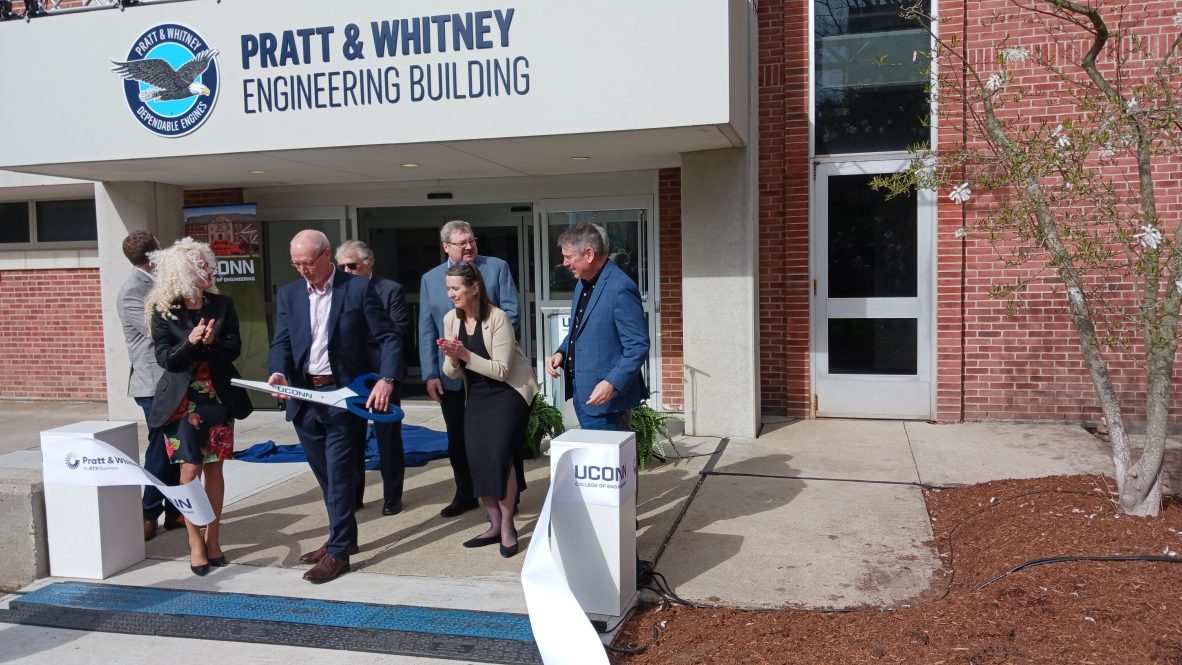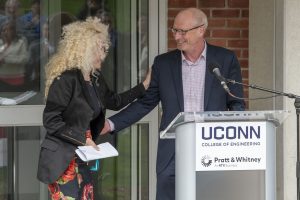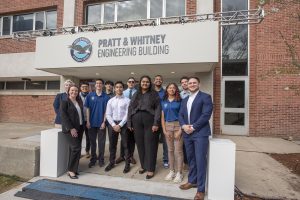Pratt & Whitney has strong ties to the UConn College of Engineering and UConn School of Mechanical, Aerospace and Manufacturing Engineering

Leaders from the University of Connecticut College of Engineering and Pratt & Whitney recently marked a new milestone in innovation and collaboration.
On April 19, leaders from the two organizations recognized the newly named Pratt & Whitney Engineering Building in a ceremony at UConn Storrs.

The renaming of the building, formerly known as the United Technologies Engineering Building, served as a timely reminder of the interconnectedness of academia and industry. By bridging the gap between theory and practice, UConn and Pratt & Whitney are paving the way for transformative discoveries and advancements that will shape the future of engineering and beyond.
"The prevalence of the aerospace industry has been a constant in Connecticut," UConn President Radenka Maric said during Friday's event. "We come full circle today, recognizing Pratt & Whitney as one of the state's longest established aerospace companies, and for its ties to UConn College of Engineering and the UConn mechanical engineering teams."
Friday's event brought UConn stakeholders including Maric, Anne D'Alleva, provost and executive vice president for academic affairs; and Kazem Kazerounian, engineering dean. Also in attendance were the students benefitting from the Pratt & Whitney Scholars Program.
UConn Growth
In 1920, the Division of Mechanical Engineering moved into its own building on the Storrs campus and graduated its first engineering student. The original building first opened on campus in 1986 following a $1.5 million contribution from United Technologies. Since then, the building has seen the mechanical engineering department grow into the School of Mechanical, Aerospace and Manufacturing Engineering. Currently, about 65% of Connecticut's engineers are UConn graduates, and the continued demand for engineers in the state has driven growth in the school's enrollment, degree offerings, curricula, industry partnerships, and research impact over the last several years.
Industrial Advancement
Pratt & Whitney is a global leader in aerospace innovation and has long been synonymous with groundbreaking advancements in engineering. With deep connections to the state of Connecticut, Frederick Rentschler founded the company in 1925. Its first engine, the R-1340 Wasp, transformed military and commercial aviation and is still in use today. In April 2020, United Technologies merged with Raytheon Company, and together became the RTX Corporation. Pratt & Whitney is an RTX business.
"The newly named Pratt & Whitney Engineering Building is a testament to the strength of the partnership between UConn and Pratt & Whitney, which dates back decades and is built on two key pillars: research and talent," said Pratt & Whitney Vice President Geoff Hunt during Friday's event.
Educating, and Transporting, a Modern World
Both UConn and Pratt & Whitney are committed to a future of environmental responsibility, social equity, and economic viability.
UConn has established an ambitious goal to achieve carbon neutrality by 2030. As part of the UConn Sustainability Action Plan, the university will also conserve resources; integrate sustainability across UConn's academic and research activities; ensure equity and engagement; and establish partnerships and support innovation that addresses sustainability challenges.

Pratt & Whitney is committed to supporting the aerospace industry in its goal of reaching net zero aviation carbon dioxide emissions by 2050. Progress includes smarter technology like hybrid-electric propulsion and building engines to burn cleaner fuel. The company has partnered with key sustainable organizations like the Air Transport Action Group, the International Civil Aviation Organization, and the Commercial Aviation Alternative Fuels Initiative to meet those goals.
Part of Pratt & Whitney's recent commitment to the UConn College of Engineering includes the Pratt & Whitney Scholars Program, a $1.25 million investment to serve underrepresented minorities. Those scholars were recognized in a Vergnano Institute for Inclusion showcase later that night.
This partnership was also recently recognized by the Connecticut Office of Workforce Strategy. The Vergnano Institute and Pratt & Whitney earned an honorable mention for the inaugural Governor's Workforce Partnership Awards and were recognized last week.

Past, Present, and Future
The 1986 groundbreaking ceremony program ended with a simple, but timeless, note that still rings true today: "Our common goal is a building filled with students, faculty and staff working and learning together in a first-class teaching and research facility." Friday's event offered a chance to reflect on the soaring progress of the last century. From Wilbur and Orville Wright's earliest attempts to take to the skies, to the latest advancements in sustainable aviation fuel, UConn and Pratt & Whitney humbly join an ever-growing crew of aerospace innovators. Together, Pratt & Whitney and UConn aim to shape the future of aviation by creating well-rounded engineers ready to tackle the challenges of the next century.






